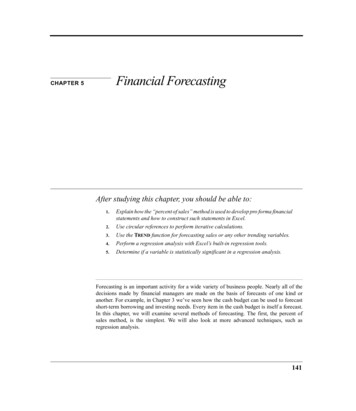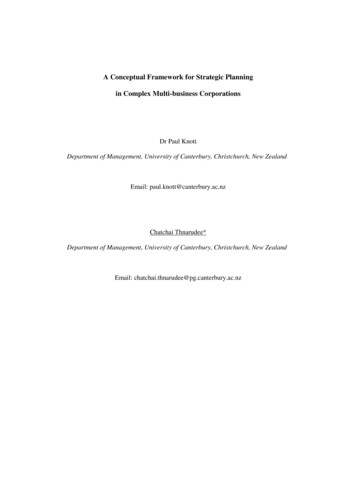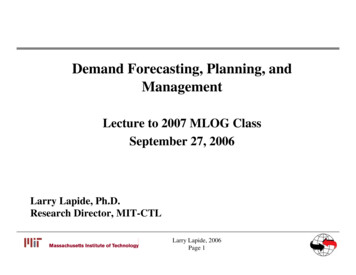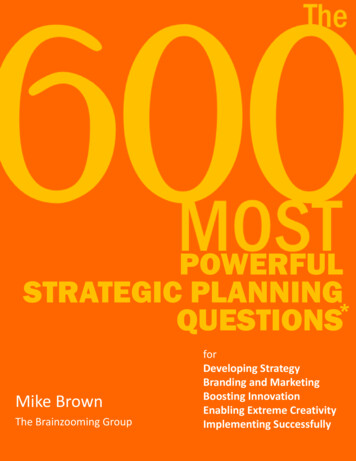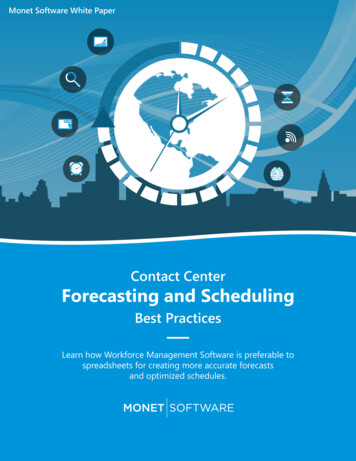
Transcription
University of PennsylvaniaScholarlyCommonsMarketing PapersWharton School1-1-1983Strategic Planning and Forecasting FundamentalsJ. Scott ArmstrongUniversity of Pennsylvania, armstrong@wharton.upenn.eduFollow this and additional works at: http://repository.upenn.edu/marketing papersPart of the Marketing CommonsRecommended CitationArmstrong, J. S. (1983). Strategic Planning and Forecasting Fundamentals. Retrieved from http://repository.upenn.edu/marketing papers/123Postprint version. Published in The Strategic Management Handbook, edited by Kenneth Albert (New York: McGraw-Hill 1983), pages 1-32.The author asserts his right to include this material in ScholarlyCommons@Penn.This paper is posted at ScholarlyCommons. http://repository.upenn.edu/marketing papers/123For more information, please contact repository@pobox.upenn.edu.
Strategic Planning and Forecasting FundamentalsAbstractIndividuals and organizations have operated for hundreds of years by planning and forecasting in an intuitivemanner. It was not until the 1950s that formal approaches became popular. Since then, such approaches havebeen used by business, government, and nonprofit organizations. Advocates of formal approaches (forexample, Steiner, 1979) claim that an organization can improve its effectiveness if it can forecast itsenvironment, anticipate problems, and develop plans to respond to those problems. However, informalplanning and forecasting are expensive activities; this raises questions about their superiority over informalplanning and forecasting. Furthermore, critics of the formal approach claim that it introduces rigidity andhampers creativity. These critics include many observers with practical experience (for example, Wrapp,1967). This chapter presents a framework for formal planning and forecasting which shows how they interactwith one another. Suggestions are presented on how to use formal planning for strategic decision making. (Forsimplicity, references to planning and forecasting in this chapter will mean formal strategic planning andforecasting.) Planning is not expected to be useful in all situations, so recommendations are made on whenplanning is most useful. Descriptions of forecasting methods are then provided. Finally, suggestions are madeon which forecasting methods to use when developing plans for a company.DisciplinesMarketingCommentsPostprint version. Published in The Strategic Management Handbook, edited by Kenneth Albert (New York:McGraw-Hill 1983), pages 1-32.The author asserts his right to include this material in ScholarlyCommons@Penn.This journal article is available at ScholarlyCommons: http://repository.upenn.edu/marketing papers/123
Strategic Planning And Forecasting FundamentalsJ. Scott ArmstrongFrom Kenneth Albert (ed.), The Strategic Management Handbook.New York: McGraw Hill, 1983, pp. 2-1 to 2-32.Individuals and organizations have operated for hundreds of years by planning andforecasting in an intuitive manner. It was not until the 1950s that formal approaches becamepopular. Since then, such approaches have been used by business, government, and nonprofitorganizations. Advocates of formal approaches (for example, Steiner, 1979) claim that anorganization can improve its effectiveness if it can forecast its environment, anticipate problems,and develop plans to respond to those problems. However, informal planning and forecasting areexpensive activities; this raises questions about their superiority over informal planning andforecasting. Furthermore, critics of the formal approach claim that it introduces rigidity andhampers creativity. These critics include many observers with practical experience (for example,Wrapp, 1967).This chapter presents a framework for formal planning and forecasting which shows howthey interact with one another. Suggestions are presented on how to use formal planning forstrategic decision making. (For simplicity, references to planning and forecasting in this chapterwill mean formal strategic planning and forecasting.) Planning is not expected to be useful in allsituations, so recommendations are made on when planning is most useful. Descriptions offorecasting methods are then provided. Finally, suggestions are made on which forecastingmethods to use when developing plans for a company.Where possible, the advice on planning and forecasting is supported by relevant research.In some areas much research exists. (For a review of the psyc hological literature on forecastingand planning, see Hogarth and Makridakis, 1981.) In many areas, however, little research hasbeen done.Various aspects of formal planning and forecasting are illustrated here by using thestrategic decision by Ford to introduce the Edsel automobile in 1957. In this situation, formalplanning and forecasting would have been expected to be useful. Judging from publishedaccounts by a participant at Ford (Baker, 1957) and an observer (Brooks, 1969), Ford did not useformal planning and forecasting for the strategic decisions involved in the introduction of theEdsel. (Of course, having decided intuitively to proceed, they did carry out operational planningfor the production of the car.) The introduction of the Edsel is regarded as one of the largestbusiness errors of all time. Ford itself lost 350 million. Their dealers also lost a substantialamount. Is it possible that formal planning and forecasting might have protected Ford from sucha large strategic error?With acknowledgments to Richard C. Hoffman IV, Spyros Makridakis, Deepak Mehta and RobertFildes, who provided useful comments on various drafts of this chapter. Support for this paper wasprovided by IMEDE in Lausanne, Switzerland.
Figure 2-1 provides a framework to conceptualize strategic planning within a company.A scanning of the environment yields relevant data for the “Data Bank.” This data bank (orinformation system) would contain such data as government regulations, demographic indicators,industry sales, the resources of the company and of its competitors, and information on availabletechnologies for production. Ideally, these data would be assembled in a central location, such asin a filing cabinet, chart room, or computer.The left- hand side of Figure 2-1 examines planning. A variety of planning processes canbe used. These will be described in more detail below. The planning processes draw uponinformation from the data bank (evidence on the current situation) and also upon the forecastsevidence on what will happen in the future). The two-way arrow from “Data Bank” to “PlanningProcesses” indicates that the planning process, to a large extent, dictates what information isrequired. It is recommended that formal planning start with the planning process rather than withthe data.The planning process produces a set of plans. These describe objectives and alternativestrategies. One strategy is selected as a basis for action. In practice, the actions actually taken bythe company can deviate substantially from the intended strategy. The actions lead to results,both intended and unintended. A record of these results is kept in the data bank.The right-hand side of Figure 2-1 examines forecasting. To make forecasts for acompany, it is necessary to have information about the company's proposed strategies (thus thearrow from “Plans” to “Forecasting Methods”). An examination of the forecasting methods,then, will help determine what data are required (thus the two-way arrow from “Data Bank” to“Forecasting Methods”). The forecasting methods, to be described in more detail below, yield aset of forecasts. What will happen if the company attempts strategy A and environment Xoccurs? How likely is environment X? How much confidence can we have in the forecast? Theseforecasts are then used as inputs to the planning process.Note the distinctions between forecasting and planning. Planning provides the strategies,given certain forecasts, whereas forecasting estimates the results, given the plan. Planning relatesto what the firm should do. Forecasting relates to what will happen if the firm tries to implementa given strategy in a possible environment. Forecasting also helps to determine the likelihood ofthe possible environments.The remainder of this chapter discusses the items in the two circles on Figure 2-1, thePlanning Process and Forecasting Methods.2
DESCRIPTION OF THE STRATEGIC PLANNING PROCESSFormal strategic planning calls for an explicit written process for determining the firm'slong-range objectives, the generation of alternative strategies for achieving these objectives, theevaluation of these strategies, and a systematic procedure for monitoring results. Each of thesesteps of the planning process should be accompanied by an explicit procedure for gainingcommitment. This process is summarized in Figure 2-2. The arrows suggest the best order inwhich to proceed. The need for commitment is relevant for all phases. The specification ofobjectives should be done befo re the generation of strategies which, in turn, should be completedbefore the evaluation. The monitoring step is last. The dotted line indicates that, to some extent,the process is iterative. For example, the evaluation may call for going back to the generation ofnew strategies, or monitoring may require a new evaluation of strategies.3
The various steps of the planning process are described below along with some formaltechniques that can be used to make each step explicit. (Although commitment is the first step, itis easiest to discuss this last.) This discussion is prescriptive; it suggests how planning should bedone. Numerous accounts are available of how formal strategic planning is done (for example,see Wood, 1980, and the extensive review of the descriptive research by Hofer, 1976).Specify ObjectivesFormal planning should start with the identification of the ultimate objectives of theorganization. Frequently, companies confuse their objectives (what they want and by when) withtheir strategies (how they will achieve the objectives). For example, suppose that a companydesires to make money for its stockholders. To do this, it decides to build a tunnel through amountain in order to charge tolls to automobiles. They plan to complete the tunnel in five years.On the way through the mountain, they strike gold. To mine the gold, activities on the tunnelmust be suspended. Does the company pursue its objective of making money or does it stay withits strategy of tunnel building? What would your organization do?The analysis and setting of objectives has long been regarded as a major step in formalstrategic planning. Informal planners seldom devote much energy to this step. For example, inBaker's (1957) summary of the Edsel, less than 1 percent of his discussed concerned objectives.Unfortunately, the identification of objectives is a difficult step for organizations. It is evendifficult for individuals. The simplest way to demonstrate this is the following: Ask yourself toset objectives for your use of this chapter. Write your objectives. Be specific. Find measurableobjectives. Set time deadlines for implementing changes. It is possible (for example, you couldhave as an objective that you will take action within the next month on at least one technique toimprove the strategic planning of your organization), but it is stressful.The difficulties in setting objectives have led some observers to recommend that formalplanners ignore this step. The recommendation here is just the opposite. Significant time andmoney should be allocated to the analysis of objectives. This difficult step might be aided by useof an outside consultant to help the group focus only upon the objectives. The question can also4
be attacked by asking what results would define successful performance by the company over thenext twenty years. At this stage, no concern should be given as to how to achieve the objectives.Companies pursue many objectives and planners should explicitly recognize all of theimportant objectives of the system. One way to help ensure that the analysis of objectives iscomprehensive is to use the stakeholder approach. This calls for a listing of all groups thatcontribute resources to the firm. Then a description is provided of the objectives of each of thesestakeholders.Applying the stakeholder approach in the Edsel case, the following groups would beincluded: creditors, stockholders, employees, consumers, suppliers, dealers, and the localcommunity. In many cases, these groups will have conflicting objectives. The planners wouldwrite out the objectives for each group, for example, return on investment (ROI) forstockholders; stability, good wages, and good working conditions for employees; safe andreliable products at a low price for consumers; ROI for the dealers. Specific measures would thenbe established for each objective (for example, ROI should exceed 10 percent per year after taxesin real dollars). In contrast to this stakeholder approach, Ford's informal approach led to a narrowobjective: “to obtain 3.3 percent to 3.5 percent of the auto market” (Baker, 1957). Explicitconsideration was not given to other stakeholders.A strengths and weakness analysis should then be conducted. This calls for an inventoryof the organization's resources (such as financial, marketing, production). What do they havenow and what do they plan to have? The objectives would then be drawn from what is desired(stakeholder analysis) and what is feasible (strengths and weakness analysis).The written statement of objectives should start with the ultimate objectives. Thesegeneral objectives would then be translated into more specific objectives so that each decisionmaker can see how to contribute to the overall objectives. In addition to being specific, theobjectives should be measurable (Latham and Kinne, 1974). The objectives would includestatements on what is desired and when. Thus, the marketing department can refer to theplanning manual to determine its role in meeting the overall company objectives.One danger in planning is that the objectives may become confused with the strategies.For example, a company might decide that one strategy, to better meet the needs of itsstakeholders, is to increase its market share during the next five years. But this strategy mightfalsely be regarded as an objective by the marketing department. Five years later, the departmentmight still pursue market share—even if it is detrimental to the company's objectives. (Theycontinue to build the tunnel and ignore the gold.)Advocates of informal planning argue that specific written objectives create politicalproblems within the organization. Vague objectives allow for the greatest flexibility in actions.Politically oriented leaders often prefer that the objectives be unstated. But evidence from studiesin organizational behavior suggests that explicit and specific objectives are of substantial benefit,especially when used in conjunction with the other planning steps (see reviews of this research inLatham and Yukl, 1975; Tolchinsky and King, 1980; and Locke et al., 1981).5
Once the objectives have been specified, the planners can proceed to the generation ofstrategies. If the objective setting was successful, the remaining steps will be easier.Generate Alternative StrategiesA strategy is a statement about the way in which the objectives should be achieved.Strategies should be subordinate to objectives. That is, they are relevant only to the extent thatthey help to meet the objectives.This advice is obvious but often ignored. The generation of alternative strategies helps toavoid this problem. It recognizes explicitly that the objectives may be achieved in many differentways.Strategies should first be stated in general terms. The more promising strategies should beexplained in more detail.The planning process is not complete until the company has at least one (and preferablymore than one) operational strategy. An operational strategy describes:1. What tasks must be done2. Who is responsible for each task3. When each task must be started and completed4. The resources (time and money) available for each task5. How the tasks relate to one anotherThis operational strategy becomes the basis for action by various functions in the firm: finance,personne l, production, and marketing.Alternative strategies can improve the adaptability of the organization in two ways. First,by explicitly examining alternatives, it is likely that the organization will find some that aresuperior to their current strategy. Second, the environment might change; if alternative(contingency) plans have been prepared, the organization is in a better position to respondsuccessfully. Alternatively, they can select a strategy that performs well even if the environmentchanges.Organizations sometimes have difficulty developing alternative strategies to deal withunfavorable environments (threats). One technique that can help organizations with this problemis the use of scenarios. This involves having decision makers write stories about the future oftheir company. They can write a scenario describing what will happen to their company if thethreat occurs, given their current strategy. Then, they could write about a desired future. Whatwould they want the company to be like? The question then becomes, “What must we do toachieve this type of future?” Consideration can be given to changing the organization's resourcesor to the use of alternative strategies.6
The development of scenarios calls for creativity within the organization. To bring outthis creativity, it is helpful to use brainstorming. Key stakeholders for the organization can beasked to consider alternative strategies, alternative resources, and alternative environments byfollowing these rules for brainstorming:1. Gain agreement within the group to use brainstorming.2. Select a facilitator. The facilitator:a. Records ideas as they are mentionedb. Encourages quantity of ideasc. Reminds the group not to evaluate (either favorably or unfavorably)d. Encourages wild idease. Does not introduce ideasFor a more complete description of scenarios, see Armstrong (1978a, pp. 38-43), Ackoff (1970,pp. 24-29), and Chapter 10.It is difficult to say how many alternative strategies should be listed. Certainly more thanone! But the number could quickly get out of hand considering the vast number of possiblecombinations. Try to list strategies to deal with dramatically different yet likely environments.After this larger list has been developed, screen the list to determine which strategies should bedeveloped in more detail.Two guidelines appear to be of particular importance for the development of a strategy.The strategy should be comprehensive and it should provide slack.To ensure that strategies are comprehensive, planners have typ ically suggested the use offlow charts. These list each of the key tasks that must be accomplished and show how each taskrelates to the others. Numerous publications have offered advice in this area (for example,Ansoff, 1965; Steiner, 1979). Slack means that resources (time, money, facilities) should not befully committed to the recommended strategy. Some resources should be held in reserve; thesecan be used to relieve stress if parts of the plan break down. Slack is analogous to the use ofinventories. The use of slack adds flexibility to the plan.The Edsel case illustrated the informal approach to strategic planning. Ford decided tobuild a large, powerful, and ornate automobile. They did not report that they examinedalternatives. Their plan did no t appear to be comprehensive, and no mention was made ofprovision for slack. The environment changed prior to the introduction. Ornate cars were not sopopular, small foreign cars were capturing a growing market segment, large powerful engineswere the subject of much criticism, and a small recession was under way when the first Edselscame onto the market. But Ford had no contingency plans. In retrospect, low-cost contingencyplans could have been introduced. For example, the distribution of the cars could have been doneprimarily through existing dealers rather than through the new Edsel dealer network. (Thisrecommendation was proposed by management students who developed a plan for a disguisedversion of the Edsel case. Most of these students, who had been asked to try formal planning,decided to use the existing dealer network.)7
Evidence from studies in organizational behavior suggests that, in general, the generationof ideas should be separated from the evaluation of ideas (Mater, 1963); they cannot be donetogether with much effectiveness. Thus, this step of generating alternatives should be completedbefore the next step is begun.Evaluate Alternative StrategiesOnce sufficient strategies have been proposed, the evaluation of alternatives can begin.This requires a procedure by which each alternative plan is judged for its ability to meet theobjectives of the organization. Such a process is not simple, because conflicting objectivesusually exist among stakeholders. Furthermore, the presence of uncertainty complicates thechoice of a strategy. For example, one should consider not only how well the strategy does forthe most likely situation, but also how well it does against other possible situations, especiallythose that are dramatically different.One procedure for the evaluation of alternatives is the Delphi technique. Variousstrategies (for a given environment) are presented to the key stakeholders. Each person worksindependently to rank these alternatives. A summary of the group rankings is then presented tothese same stakeholders, and they are asked to provide a second ranking, still workingindependently. This procedure can be repeated for a number of "rounds" As a variation, groupdiscussion can be used to exchange information between rounds. The Delphi technique providesa more efficient and less biased way to use the information held by the key decision makers thanthat provided by informal methods (for more on Delphi see Linstone, 1975).The use of scenarios is also relevant to evaluation, particularly when dealing withnegative evidence from the environment. Much research suggests that organizations avoidunpleasant information. As an example of this tendency to reject negative evidence, Griffith andWellman (1979), in a study of expansion plans in six hospitals, found that forecasts of decreasingdemand were ignored. As a result, the hospitals overbuilt. The use of scenarios might haveidentified the reactions to unfavorable forecasts prior to investing money on these forecasts. Thehospitals could then have canceled the proposed expenditures on forecasting if they could notdecide how the forecasts might affect their decision making.Other formal procedures for evaluation can also be used. For example, structured ratingsheets can be used to evaluate the general strategies against the stakeholders' objectives and togauge the extent to which negative information was considered. Also, one could rate eachoperational strategy on the extent to which it succeeded in the following areas: providedadequate resources, allowed adequate slack, set reasonable time deadlines, presented acomprehensive strategy, and presented an operational strategy. The use of the devil's advocate,when a person argues against a favored alternative, can help to ensure that both sides of a planare considered (Cosier, 1978).The major point for evaluation is to use formal procedures and to not use informal ones,such as the traditional group meeting. The latter provides one of the poorest ways to evaluatestrategies. Janis (1971) examined a number of major failures in strategy evaluation, such as the8
Bay of Pigs, and concluded that much of the blame was due to the lack of formal processes forevaluation. He provided a checklist that groups can use to improve their ability to generate andevaluate alternative strategies.The evaluation step concludes with the selection of an operational strategy. This is thestrategy the company will attempt to implement. (This strategy should contain contingency plansalso.) But will the strategy really meet the objectives? To assess this, the next step of theplanning process, monitoring results, is taken. This step is prepared prior to the implementationof the strategy.Monitor ResultsThe value of feedback has been well established in laboratory studies, especially whencombined with the setting of objectives (Tolchinsky and King, 1980; Ilgen, Fisher, and Taylor,1979). Field studies have also demonstrated the value of explicit feedback (for example, Becker,1978). It seems important, then, to provide feedback to the organization on how well they aremeeting their objectives. In other words, specific procedures should be developed to “monitorresults.”The monitoring system should allow for corrective action. To do this, the following itemsshould be measured in a systematic way:1. Changes in the environment (sometimes called “environmental scanning”)2. Changes in the organization's capabilities (and in their competitors' capability)3. Actions that were actually taken by the organization (did they implement thedesired strategy?)4. Actions by major competitors5. ResultsPlanning involves a trade-off between consistency and flexibility. Formal planners try todevelop a strategy so that a complex organization can operate in a coordinated manner. Themembers of the organization must sacrifice flexibility in order to follow a consistent strategy.However, changes in any of items 1 to 5 above could suggest a change in strategy. Thus, themonitoring system should signal when a change in strategy should be considered.Fixed review times should be selected in advance. Many firms conduct a review once ayear. At these times, decisions should be made whether to continue with the original strategy,revise the strategy, or switch to a contingency plan. For very large changes it is best to view thestrategy as being experimental and to schedule more frequent review periods, perhaps quarterly.In addition to fixed review times, the monitoring system should also have control limits. Thesewould be upper and lower bounds for each of the above five areas. When the system goes outsideof these limits, a planning review would be conducted whether or not it was time for the fixedreview.9
The monitoring of outcomes should relate back to the objectives for each stakeholder.This should allow for a comparison to be made between results and objectives in order to decidewhether the strategy is successful for each stakeholder.The monitoring system is expected to have a greater impact if it is tied into theorganization's incentive system. This helps to ensure that the participants are committed to theobjectives described in the plan. Companies sometimes develop comprehensive plans, but thenfocus solely on the stockholders or the managers. The monitoring system should focus on thelong-range impact of the plan on all of its stakeholders. For example, to recognize the interests ofits customers, IBM uses consumer-satisfaction surveys to help determine management'scompensation.In the Edsel case, no monitoring procedure had been developed. Substantial confusionseemed to occur when the initial results were examined. What results constituted a failure? Thishad not been defined in advance. Some months after what seemed to be a disastrous introduction,Ford told its dealers that there was no cause for alarm (Brooks, 1969). Apparently, Ford wasunable to respond rapidly to evidence that their strategy was failing.The Edsel monitoring procedure, or lack of it, is apparently not unusual. Horovitz (1979),in a survey of the planning practices of 52 large firms in Great Britain, France, and WestGermany, found that virtually none of them had a formal procedure for monitoring results oftheir long-range plans.One way to improve the monitoring of results is to have an evaluation performed eachyear by an independent auditor. The following questions could be addressed: Is the monitoringsystem comprehensive? Is the planning process adequate? Is the forecasting process adequate?(A procedure for the auditing process for forecasting is provided in Armstrong, 1982a.)Seek CommitmentBusiness plans and forecasts are frequently ignored; at other times they are used torationalize a course of action previously decided. What can be done to develop commitment tothe planning process? What can be done to ensure that the various stakeholders will cooperateand try to implement the chosen strategy? Attention should be given to commitment throughouteach of the above steps in planning.Formal planning calls for an explicit procedure for gaining commitment to the plan. Afirst condition is that key stakeholders should be evolved in the planning process. This wouldmean, at least, that information should be obtained from these stakeholders.Publicly stated objectives are a requirement if the objectives are expected to have animpact on behavior. Each stakeholder group and each key decision maker should be aware of theobjectives. This can help to achieve consensus.10
Commitment to objectives is expected to be higher if those who are affected by thestrategic decisions participate in the objective-setting process. In other words, self-set objectivesare more likely to be attained than objectives set by others. This generalization is based onlaboratory studies (for example, Bass, 1977) and on field studies. Participation is not necessaryin all situations; however, it generally helps, and seldom does it make things worse.Participation by stakeholders is also helpful in the generation and evaluation ofalternative strategies (Van de Ven, 1980). This is most important where the strategy involveslarge changes, because the threat to the various stakeholders is reduced if they have some controlover these changes.Commitment can be maintained more effectively if the monitoring system providesquantita
Strategic Planning and Forecasting Fundamentals Abstract Individuals and organizations have operated for hundreds of years by planning and forecasting in an intuitive manner. It was not until the 1950s that formal approaches became popular. Since then, such approaches have been used by bu


